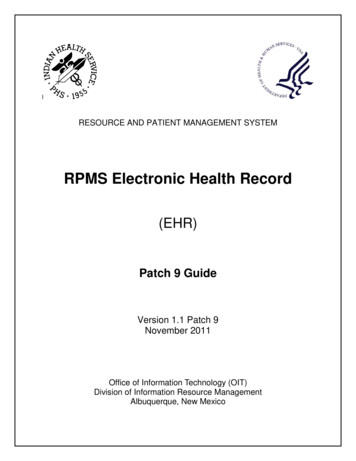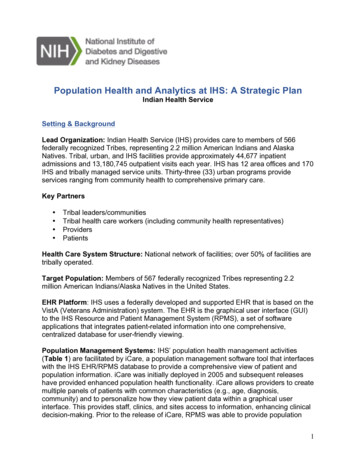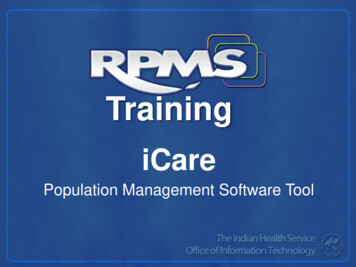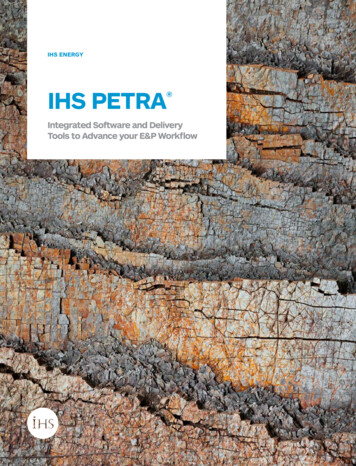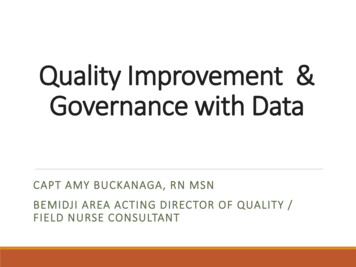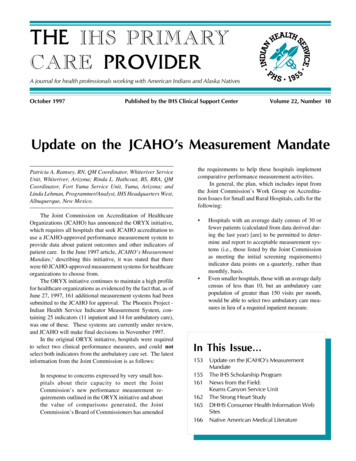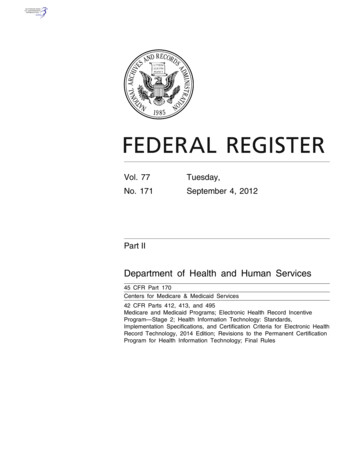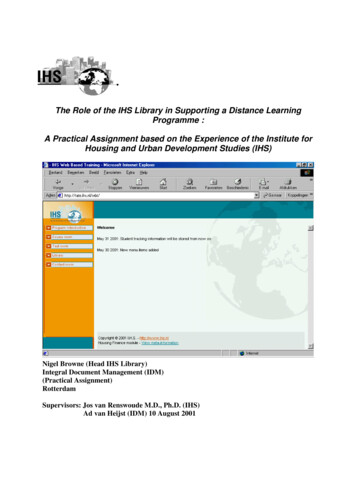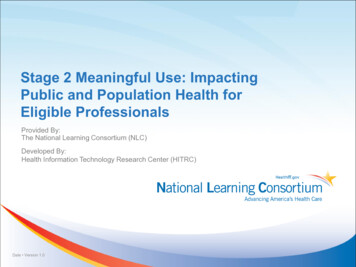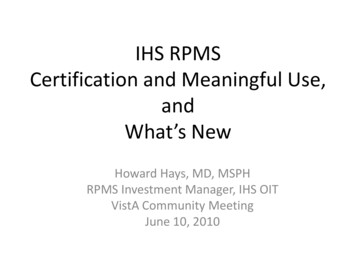
Transcription
IHS RPMSCertification and Meaningful Use,andWhat’s NewHoward Hays, MD, MSPHRPMS Investment Manager, IHS OITVistA Community MeetingJune 10, 2010
Topics RPMS Certification and Meaningful Use RPMS Development in 2010
Meaningful Use ofElectronic Health RecordsThe American Recovery and Reinvestment Actof 2009 (ARRA – aka Recovery Act) authorizesthe Centers for Medicare & Medicaid Services(CMS) to provide substantial reimbursementincentives for eligible professionals andhospitals who are successful in becoming“meaningful users” of certified electronichealth record (EHR) technology.
Real Life Example of Meaningful Use
Certification & Meaningful Use Certification and Meaningful Use are twodifferent things– Certification attests to the functions andcapabilities of the EHR system– Meaningful Use attests to whether the system isactually being implemented and used A facility can install and run an EHR systemwithout having “meaningful use” of thesystem
RPMS ARRA Activities Focused on Certification and Meaningful Use inorder to enable OIT’s customers to takeadvantage of CMS incentives starting in 2011 Certification:– Re-Certification of Ambulatory EHR in 2010– Certification of Inpatient EHR in 2010 Meaningful Use:– Accelerated deployment activities to optimize: Inpatient pharmacy package configuration and useLaboratory package and Reference Lab InterfaceOutpatient pharmacy packageInpatient nursing processes and Bar Code MedicationAdministration VistA Imaging – scanning, clinical images, PACS
Congressional Requirements forMeaningful Use1. Use a Certified Electronic Health Record (EHR) ina Meaningful way.2. Use an EHR that can exchange information withother systems electronically.3. Submit reports to CMS that include performancemeasures proving meaningful use.These requirements were published for publiccomment. IHS submitted its comments onMarch 15, 2010.
Meaningful UseTimeline Meaningful Use occurs in three stages, with Stage 1starting in 2011 New rules will be published in 2013 and 2015 (Stages 2 and 3) –each stage will be more comprehensive Focus areas for each stage Stage 1: Data capture and sharing Stage 2: Advanced clinical processes* Stage 3: Improved outcomes** Requirements for Stages 2 and 3 will be defined in future CMS rulemaking.
Meaningful UseTimeline The later the start, the more requirements needed tomeet in a shorter period of timeStage of Meaningful Use Criteria by Payment Year1st PaymentYear20112012201320142015 2011Stage 1Stage 1Stage 2Stage 2Stage 3Stage 1Stage 1Stage 2Stage 3Stage 1Stage 2Stage 3Stage 1Stage 32012201320142015Payment YearStage 3NOTE: The number of payment years available and the last payment year that can bethe first payment year for a provider or hospital varies between the EHR incentiveprograms.
CMS Incentive Programs
CMS Incentive Programs Both Medicare and Medicaid will provide financialincentives for meeting Meaningful Use Medicare incentives run 2011-2015. Medicaid 2011-2021. However, states are notrequired to participate in the program. If they do notparticipate, providers in the state will not receiveincentive payments. Medicare will impose penalties beginning in 2015 forNOT meeting Meaningful Use.
CMS Incentive Programs (cont’d)– Exception: The first year of the Medicaidincentives only require adopting, implementing,or upgrading to certified EHR technology and donot require the achievement of meaningful use.All other years require demonstration ofmeaningful use.
CMS Incentive Programs (cont’d) Provider incentive programs run on a calendar year andhospitals run on a federal fiscal year To take maximum advantage of the incentives:– Providers need to be ready by January 1, 2011– Hospitals need to be ready by October 1, 2010 Providers may qualify for Medicare or Medicaidincentives, not both– Providers may make a one-time change prior to 2015 Subsection D/Acute Care hospitals may qualify for bothincentive programs Critical Access Hospitals only qualify for the Medicareincentive program
Criteria for ProvidersMEDICAREMEDICAIDNon-hospital based* physicians, defined as anyof the following: Doctor of Medicine or Osteopathy Doctor of Dental Surgery or Medicine Doctor of Podiatric Medicine Doctor of Optometry ChiropractorNon-hospital based* providers defined as anyof the following EXCEPT for any providershown below that practices predominantly†in a Federally Qualified Health Center(FQHC) or Rural Health Clinic (RHC): Physicians Dentists Certified Nurse-midwives Nurse Practitioners Physician Assistants who are practicing inFQHCs or RHCs led by a physician assistant† When the clinic location for over 50% of totalpatient encounters over a period of 6months occurs at an FQHC or RHC* A hospital based physician/provider is defined as furnishing 90% or more of their coveredprofessional services in a hospital setting (inpatient or emergency room). CMS determinesthis by the Place of Service (POS) codes on physician claims. If they are POS codes 21 or 23,the provider is considered a hospital based provider.
Additional Medicaid ProviderEligibility Criteria Medicaid patient volume requirementsEntityMinimum 90-dayMedicaid PatientVolume ertified Nurse Midwives30%Physician Assistants (whenpracticing at anFQHC/RHC led by aphysician assistant)30%Nurse Practitioner30%Acute care hospital10%Children’s hospitalsNoneOr the MedicaidEligible Providerpracticespredominately in anFQHC or RHC- 30%“Needy individuals”patient volumethresholdN/A
Additional Medicaid ProviderEligibility Criteria (cont’d) Additional information on patient volume requirementsMedicaid Patient Volume RequirementsProvider TypePatient Volume Requirement Non-hospital based physicians, dentists,certified nurse midwives, nursepractitioners PAs practicing at an Federally QualifiedHealth Center/Rural Health Clinic led bya PA) 30% of all patient encounters attributable toMedicaid over any continuous 90-day period inthe most recent calendar year prior toreporting 20% for pediatricians Any of the above practicingpredominantly in an Federally QualifiedHealth Center (FQHC) or Rural HealthClinic (RHC) (when the FQHC/RHC isthe clinical location for over 50% of totalencounters for 6 months in the mostrecent CY) 30% of all patient encounters attributable to“needy individuals” over any continuous 90-dayperiod in the most recent calendar year priorto reporting “Needy individuals” include: Medicaid orCHIP enrollees, patients furnisheduncompensated care by the provider, orfurnished services at no cost or on a slidingscale.
Criteria for Eligible HospitalsMEDICAREMEDICAID Subsection (d) hospitals that eitherreceive reimbursement for services underMedicare Fee-for-Service (FFS) program orare affiliated with a qualifying MedicareAdvantage (MA) organization Acute care hospitals Includes inpatient, acute care hospitals inthe State of Maryland Excludes psychiatric, rehabilitation, longterm care, children’s, and cancer hospitals Critical access hospitals (CAHs) A facility that has been certified as a criticalaccess hospital under section 1820(c) ofthe Social Security Act Patient volume requirements: None A health care facility where the averagelength of patient stay is 25 days or fewerAND has a CMS Certification Number(CCN) in the range of 0001-0879 Includes short-term general hospitalsand the 11 cancer hospitals in the U.S. Children’s hospitals Must have a CCN in the range of 33003399 Predominantly treats individuals under 21years of age Patient volume requirements Acute care hospitals 10% of all patient encountersattributable to Medicaid over anycontinuous 90-day period in the mostrecent calendar year prior to reporting Children’s hospitals: None
Incentives ligibleProvidersHospitalsIncentivesStartCY 2011FY 201120112011IncentivesEndCY 2016(max. 5 years)FY 2015(max. 4 years)2021(max. 6 years, muststart by 2016)2021(max. 6 years, muststart by 2016)IncentiveAmountUp to 44,000 totalper provider; basedon % MedicareclaimsVaries, dependingon % Medicareinpatient bed days.CAHs paid basedon EHR costs and %Medicare inpatientbed daysUp to 63,750 totalper provider; basedon 85% of EHRcostsVaries, dependingon % Medicaidinpatient bed daysReimbursementReducedCY 2015FY 2015No penaltiesNo penalties
Stage 1 Meaningful Use Standards andMeasures (for 2011-12)– Functional and Interoperability Measures– Clinical Quality Measures
Measuring Performance (cont’d) All or Nothing Approach– Providers and hospitals must report on allmeasures and meet any stated targets in order toachieve Meaningful Use– Measures must be reported on ALL patients, notjust Medicare and Medicaid Reporting Periods for Measures– 1st year: Continuous 90-day period– All other years: Entire year
Functional andInteroperability Measures
Functional & InteroperabilityMeasures Summary Ambulatory (Providers)– 25 measures 8 measures require “Yes” or “No” answer 17 measures require numerator and denominator– Most measures have established targets that must be met Inpatient (Hospitals)– 23 measures 10 measures require “Yes” or “No” answer 13 measures require numerator and denominator– Most measures have established targets that must be met
Functional & InteroperabilityMeasures Computerized Provider Order Entry– Ambulatory – at least 80% of all orders must beentered directly into EHR by the provider– Inpatient – at least 10% of all orders must beentered directly into EHR by the provider Drug-drug, Drug-allergy, drug-formularychecks– All sites must implement these features of EHR Problem Lists– At least 80% of patients (inpatient and outpatient)must have a current Problem List (or notation ofno problems)
Functional & InteroperabilityMeasures (cont’d) Electronic Prescribing– At least 80% of prescriptions must be entered andtransmitted electronically Medication Lists– At least 80% of inpatient and outpatients must have amedication list documented in the EHR (or notation ofno medications) Documentation of Allergies– At least 80% of inpatients and outpatients must havedrug allergies documented in the EHR (or notation ofno allergies)
Functional & InteroperabilityMeasures (cont’d) Recording Demographic Information– At least 80% of inpatients and outpatients havespecific demographic information recorded in RPMS Recording Vital Measurements– At least 80% of inpatients and outpatients age 2 andolder have vital measurements recorded in EHR,including growth charts for children Recording Smoking Status– At least 80% of inpatients and outpatients age 13 andolder have their smoking status recorded in the EHR
Functional & InteroperabilityMeasures (cont’d) Incorporate lab test results into EHR– At least 50% of all lab tests have their results recordedin the EHR Generate lists of patients with specific conditions– Generate at least one report from the EHR listingpatients with a specific condition Ability to report on Meaningful Use qualitymeasures– 2011 – manual submission of data to CMS– 2012 – electronic submission of data to CMS
Functional & InteroperabilityMeasures (cont’d) Send reminders to patients for preventive/follow-up care, perpatient preference (internet or non-internet)– Each eligible provider must send reminders to at least 50% oftheir outpatients age 50 and older Clinical decision support rules– Implement at least 5 clinical decision support rules that are linkedto the clinical quality measures Electronic insurance verification– At least 80% of outpatients and inpatients have insuranceeligibility checked electronically Electronic claims submission– At least 80% of insurance claims are filed electronically
Functional & InteroperabilityMeasures (cont’d) Provide information to patients– At least 80% of outpatients and inpatients who request electroniccopies of health records receive them within 48 hours– At least 80% of discharged patients are provided electronic copies ofprocedure reports and discharge instructions upon request Provide patients timely access to health information– At least 10% of patients can get electronic access to lab results,problem, medication and allergy lists within 96 hours after they areavailable to the provider (e.g. Personal Health Record) Clinical summaries of office visits– Clinical summaries are provided for at least 80% of office visits
Functional & InteroperabilityMeasures (cont’d) Ability to exchange data with other systems– Perform a test of system’s ability to exchange key clinicalinformation electronically, such as problem andmedication list, diagnostic test results Medication Reconciliation– Perform medication reconciliation for at least 80% ofinpatient/outpatient encounters and transitions of care Summary of care record– Provide a summary of care for at least 80% of inpatient /outpatient referrals and transitions of care Includes key information about the patient, such as diagnostictest results, problem and medication list
Functional & InteroperabilityMeasures (cont’d) Immunization Registries– Perform test of system’s ability to transmit immunizationinformation to registries Reportable Lab Results– Perform test of system’s ability to send reportable labresults to public health agencies (hospitals only) Surveillance Data– Perform test of system’s ability to electronically send“syndromic surveillance data” to public health agencies Privacy and Security– Conduct a security risk analysis of EHR system
Clinical Quality Measures
Clinical Quality MeasuresSummary Providers in ambulatory settings will reporton two measure groups– 3 core measures– 3-5 measures according to provider’s specialty Hospital measures– Required to report on 35 Medicare measures For Medicaid, hospitals have the option to report on 8alternative Medicaid measures if the 35 measures donot apply to their patient population
RPMS/EHR Development in 2010 Well Child GUI components – improved growthcharts, anticipatory guidance, education, and ASQdevelopmental screening (released) Group encounter documentation – for BH, CDE,others Nursing Flow Sheets – customizable capture anddisplay of vitals, I/O, assessments, and otherdocumentation for Inpatient, ED, day surgery, etc. Prenatal Care Module – ACOG-like prenatal formsin EHR, with persistence of data to nextpregnancy Dashboard functions for EmergencyDepartments, Urgent Care, busy clinical settings
RPMS/EHR Development in 2010 Outside Medications – Document medsprescribed elsewhere so they participate inmedication lists and order checks Electronic Prescribing – electronically sendprescription orders to commercial pharmacies viaSurescripts/RxHub network COTS Pharmacy interface – use eRx messages tocommunicate directly with a local COTS pharmacysystem such as QS1. Multiple Drug File support GUI development in Pharmacy applications Enhancements to TIU documentation functions
RPMS/EHR Development in 2010 Care Management Event Tracking (CMET) – structuredprocess for follow-up of pap smears, mammograms, etc.(initially WH oriented) Behavioral Health System v4.0 – new GUI New National Reminders & Reminder Dialogs Groundwork for web-based EHR interface Enhancements/simplification for small site deployment ofEHR Enhancements to Scheduling GUI application GUI development in Patient Registration, ADT packages Enhancements to 3rd Party Billing, Accounts Receivable Any additional development required for Certification andMeaningful Use
RPMS Well Child Module Released as part of PCC (VEN) application– Do NOT need to be running PCC to use in EHR EHR & freestanding GUI Well Child Knowledgebase– Database of thousands of pediatric guidelines andreminders– Locally customizable display Developmental Screening– Ages & Stages Questionnaire Pediatric Education documentation New printable Growth Charts
Well Child Module38
New Features in EHR v1.1p6
iCare & EHR Community Alerts Anonymous Related to Community ofResidence 30 days Splash Screen at firstlogin of the day Ready Access from manyviews: Opening View;Panel View; PatientRecord User-defined display40
Community Alerts in EHR
New Meds component Outpatient meds Inpatient meds “Outside meds”– Documentation of OTC meds, supplements– Documentation of meds ordered by outside providers “Print Prescription” that auto-finishes and prints pendingprescription– optional with parameters, only recommended at sites with NOpharmacy until ePrescribing is released “Clinical Indication” on med order dialog– optional with parameter On demand drug checker
In house ordered medsOTC & meds orderedby outside providersClicking on either component OR selecting dropdown activates section
- NEW button brings up non-VA flagged meds for selection as “OutsideMeds”- Option to add start date and add additional explanation.- “Statement/Explanation” is customizable by parameter
On demand drug checker includes pending andunsigned entries in all meds sections
Auto-Finish Currently ONLY for sites without in-house pharmacyImproved configurability will be delivered with ePrescribingAuto finish tied to “print prescription” buttonPending prescriptions finish when printedWhen set to “multipage” prints Windows-formattedprescription and site can configure how many rx’s per page When set to “single” prints text format– Delivered format can be removed and over-ridden by RPMS printformats– 3 parameters set using Header, Body and Footer– Will be used by sites whose states require special formats (and thesesites can utilize the print formats already in created)
Parameter allows/exposes Prescriptionoption
Auto-finished Rx# starts with “x”
“Multipage” view
“Single” view
Enhanced integrated signature tool Enhancement to improve safety unsignedallergy/ADR entries If user activates the integrated signature tool andthere are both non-orders (allergy/ADR entries) andorders for signature the tool signs the non-ordersfirst, then runs order checking again Must train users that right clicking to sign med ordersby-passes this safety mechanism
Enter Penicillin allergy, Order penicillin – order check stops if useintegrated signature. See on order check, runs order check again after“signing” allergy and before releasingOption to cancel
Like the lab clinical indication, med order clinical indicationoffers POV’s for current visit, Problem list, ability to search orenter text
New TIU objects – sorted by DX
Detailed meds– Pharmacistview
Medicationreconciliation
Brief andexpanded view:Parameter to setlimit for expiredmed display
Search for Note by Diagnosis
Annotating Reports (Radiology)
Reproductive factors
Family History
Infant Feeding
Asthma Classification and Control Prompt to add AsthmaClassification on ProblemList dialog Prompts to add AsthmaControl when POV forasthma selected
Desktop tools
More to Come in EHR EHR v1.1 patch 7– Reminder dialog prompts for additionalmeasurements (Behavioral Health, Asthma, OBtype measures)– “Quick Notes”– Provider friendly updates to Med Order dialog tosupport e-Prescribing– Ability to move “outside meds” to inpatient oroutpatient meds– Entry of historical measurements
Still More to Come in EHR EHR v1.1 patch 8 – C/MU Enhancementse-PrescribingGroup visit/note entryNursing Flow SheetsPrenatal Care Module
E-Prescribing RPMS certified for e-prescribing in 2008 butdid not release Re-developing due to change in interfaceengine For 2010 adding Formulary capability(required for C&MU) Future development to include Med History Tribal programs will need direct agreementwith SureScripts/RxHub
RPMS Group Notes Application Adapted from VA Group Notes and similar toGroup entry in Behavioral Health Ad hoc or standing groups Enter all visit data (including notes) for entiregroup at once Add individual data (additional notes,measurements, etc.) for specific members
Group Notes
EHR Nursing Flow Sheets Intended principally for Inpatient, but can beused in ED, Day Surgery, Observation, etc. Entry of Vital Signs, Input/Output, otherassessments. Customizable view, including graphing, that iscompressible or expandable across time. Overlapping graph capability – I/O, BP, diureticadministration, etc.
Nursing Flow Sheet Component
Prenatal Care Module (VEN 2.7) Data collection and entry for:– First Prenatal Visit– Interim Prenatal Visits– Postpartum Visit Flowchart presentation where appropriate Data carries over to future pregnancies PCM is being redesigned for better compatibilitywith EHR Nursing Flow Sheets component
iCare and CMET
Care Management Event Tracking(CMET) Track and manage screening events by retrievinginformation from the database and presenting itin a useable way Minimize the “fall through the cracks” syndromecommon in many clinical practices Minimize or eliminate the need for duplicativeentries into RPMS Replaces tracking functions of Women’s Healthpackage Delivered in iCare v2.1 and subsequently in EHR
How does it work? Extensive Data Mining for defined proceduresor events 1) Queued items for staff to evaluate 2) Decision made to track or not 3) Follow up needed - when 4) Notification of Patient
CMET Workflow1. Eventticklertickler2. Finding3. Follow-upGeneratesa dynamicRemindertickler4. Pt Notification
CMET Workflow Site sets up ‘ticklers’ Data mining generates queue of Events Users work the list to determine which of the eventswill be accepted as a CMET and then tracked Ticklers are displayed when Findings have not been entered into the CMET Follow up has not been entered into the CMET Pt Notification has not been entered into the CMET CMET Reminders are generated by the third step(Follow up) of the CMET CMET Reminders are displayed on the HealthSummary along with Health Maintenance Reminders
CMET Main View Queued Events
CMET Patient View Past Events
EHR Clinical Reminders
Reminders v1.5 p1007 New reminders that correspond to those delivered in PCCHealth Maintenance reminders Simplifies resolution logic for many of the reminders– Similar to immunization reminder findings– Single resolution logic (numerator): returns the finding from the PCCHealth Maintenance reminder– When PCC HMR logic updates, automatically updates in correspondingEHR reminder Delivers enhanced Reminder Dialogs for Pap, Mammogram,Colon Cancer, Osteoporosis screening Delivers “Reminders” for Asthma Best Practice Prompts– EHR side reminder is “due” when the Best Practice Prompt is activatedon the Health Summary
Reminders with simplified logic Alcohol screeningDomestic ViolenceDepression ScreeningHearing screeningMammogramPap SmearSenior VisionTobacco Screening
New reminders Asthma (correspond to the best practice prompts)–––––– ControlAction planPrimary care providerRisk for exacerbationSeveritySteroidsDental visitDiabetes screeningEPSDT EvaluationFunctional assessmentOsteoporosis screening
New dialog format for:Pap, Mammogram, Colon Cancer, Osteoporosis remindersDelivers field requested abilityto document historical data
New dialog format for:Pap, Mammogram, Colon Cancer, Osteoporosis reminders
Data returned for reminders with newresolution logic
Asthma reminder on when Best Practiceprompt active
Asthma dialog format
Pharmacy–Related Development EHR v1.1 p6– Outside Meds– On-demand Order Checks– Prescription Auto-Finish Support for Multiple Drug FilesCOTS-RPMS Pharmacy Interface (eRx)E-PrescribingPharmacy GUI interfacePharmacy Reports GUI
RPMS-COTS Rx “Interface” E-Prescribing messages do not need to go toSureScripts to be useful E-Rx enabled COTS applications should be ableto communicate directly with RPMS Documentation to develop suchcommunication has been developed Testing of the documentation is in planningstages at Sault Ste Marie (QS-1 customer)
Multiple Drug Files Many RPMS facilities require multiple drugfiles– Multi-divisional sites with separate pharmacies– Beneficiary/non-beneficiary treatment Multiple Drug File capability developmentunder way in RPMS– Requirements complete – in Design phase– Development should be complete this summer
Pharmacy GUI Development Absence of GUI has been frustrating for manypharmacists Current activity to develop GUI for variousworkflows:–––––Direct pharmacy order entry (from paper)Finishing provider-entered ordersPending order queueRefills (including Audiocare)Allergy entry, Allergy verification Pharmacy reports (multiple) Inpatient GUI functions will follow
Pharmacy GUI
RPMS Practice Management Suite Patient Registration Patient Information Management System (PIMS)– Scheduling– Admission/Discharge/Transfer– Sensitive Patient Tracking Third Party BillingAccounts ReceivablePharmacy Point of SaleContract Health Services / Referred CareInformation System
Patient Registration GUI
DISCUSSION
Howard Hays, MD, MSPH RPMS Investment Manager, IHS OIT VistA Community Meeting June 10, 2010. . -Accelerated deployment activities to optimize: . Laboratory package and Reference Lab Interface Outpatient pharmacy package Inpatient nursing processes and Bar Code Medication Administration VistA Imaging -scanning, clinical .
